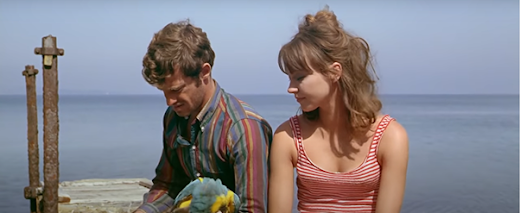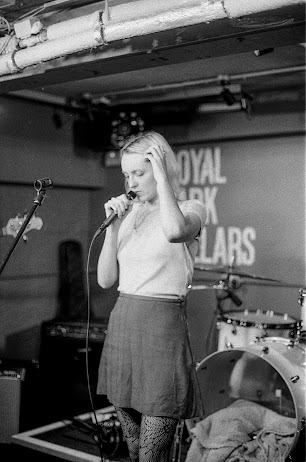A BEGINNER’S GUIDE TO FRENCH CINEMA
 |
| Pierrot Le Fou |
The
legacy of the French film pioneers, Auguste and Louis Lumiere, and Louis Le
Prince, undoubtedly lives on through the diverse catalogue of film that has
emerged from the country ever since. These men were considered the first to
invent motion picture cameras, with the Lumiere Brothers successfully creating
a ‘cinematographe,’ which could be used as both a camera and projector. The
first demonstration of this new contraption took place in a Parisian café in 1895,
leading to what we now know as cinema.
We
cannot talk about the first narrative films without the mention of Alice
Guy-Blanche. Her first film, La
Fée aux choux (1896) (also
known as The Cabbage Patch Fairy), is considered to be the first ever
narrative film, potentially pre-dating any of Georges Melies’ work. Not only does this make her most likely the
first narrative director, but also the first female director. La Fée aux
choux shows a woman in a floor-length dress, draped with flowers. She looks
like a Greek Goddess, smiling over cabbage patches and pulling real babies out
from them. She stands in front of a fence that is covered in flowers too,
symbolising fertility and blossoming. The film is less than one minute long,
but captivating, nevertheless. The legacy and influence of Alice Guy-Blanche is
often overlooked when it comes to film history, yet she was a highly important
figure in the early days of cinema, directing almost all of the film company Gaumont’s
work until 1905. Tragically, many of her films were attributed to her male
colleagues – luckily, she is now recognised for her work, yet still
overshadowed by her male counterparts.
One
of these being Georges Melies, a French illusionist. He realised that cameras
could be utilised for the filming of narrative films, experimenting with camera
trickery such as double exposure and slow-motion to create a series of pioneering
short films. His most famous experimentation is the 1902 film Le Voyage
dans la Lune. This short is a sci-fi exploration of space,
featuring camera techniques that allowed actors to disappear in a puff of smoke,
and multiple exposure was used to create effects such as the space capsule
hurling into the ocean. This is essential viewing for any film fan, as it is
one of the earliest experimentations in cinema, influencing all cinematic
techniques and themes that are commonly used today. Melies also created the
first ever horror film in 1896 - Le Manoir du Diable, which
features a bat turning into a man, skeletons, and shrouded figures. At only
three minutes long, it is not exactly what we would consider frightening today,
but its legacy is indelible.
Another
often forgotten female filmmaker who had an undeniable impact on cinema is
Germaine Dulac. To read about her 1923 short film The Smiling Madame
Beaudet in a previous blog post, click here. The aforementioned
film was an early feminist silent piece; however, she also made some highly
experimental works such as The Seashell and the Clergyman (1928), which
is widely considered to be the first surrealist film. Camera techniques were
used to appear as if a man’s head had been spliced in two, and plenty of double
exposure used to create surreal and unsettling imagery. If you were to ask
someone to name a Surrealist artist, you’d probably get the answer Salvador
Dali or Luis Buneul, however Dulac was just as important as these male artists.
The Seashell and the Clergyman’s influence can be seen in the
work of David Lynch, who almost definitely watched this film
before creating his debut Eraserhead, both evoking abstract concepts and
haunting imagery shot in black and white.
Moving
into the 1930s, disillusioned by the Great Depression, poetic realism became a
popular genre of French cinema, notable directors including Jean Renoir and
Marcel Carne. These films were often pessimistic, but there was an emphasis on
aesthetic beauty, with real life recreated in a studio. These films were often
anti-establishment and anti-patriarchy and used cinematography as a form of
politics. The Rules of the Game (1939) is one of the most
important of this period, with Renoir’s sensing of an impending second world
war shaping the themes of the film. It commentates on war’s condoning of
senseless killing, demonstrated in a hunting scene, as well as class relations
between different ranks of society. Renoir’s film is known for its striking
cinematography, focusing primarily on depth of field and tracking from character
to character, using long takes to capture the chaos of the film.
After
the war, many filmmakers were bored of the state of cinema and wanted to try
out new styles in creating films, going against traditional filmic convention.
This was highlighted in Francois Truffuat’s article in Cahiers du Cinema entitled
A Certain Tendency in French Cinema. A few years after the publication of
this, Truffuat released his debut film The 400 Blows in
1959, widely considered one of the greatest films of all time. The
coming of age tale centres around the life of troublesome but tender 14 year
old Antoine Doinel. The film utilised lots of techniques that came to be
quintessential to the French New Wave movement. This includes handheld cameras,
location shooting in the streets of Paris, improvised lines, and long natural
takes. The charm of this film shines through Jean-Pierre Leaud’s incredible
performance as Antoine, who performs perfectly as a cheeky young schoolboy who
can’t help but get himself into trouble, despite his best efforts. Certain scenes
are simply heart-wrenching, and Truffuat gives us one of the most iconic
endings in cinema, which has spread its influence throughout the years, notably
in films such as Submarine (2010, dir. Richard Ayoade).
The
French New Wave period is one of the most iconic and recognisable periods of
French cinematic history, showcasing the talents of French icons Anna Karina,
Bridgette Bardot, and Catherine Deneuve. The list is endless with countless
starlets emerging from this period, male and female, perhaps due to the New
Wave’s playful sensibility that showcased these actor’s natural charm. Another recommendation
from this period is Jean Luc Godard’s Pierrot Le Fou (1965). The
colourful and beautifully shot film is reminiscent of Bonnie and Clyde
style lover on the run movies. The film is critical of war, capitalism and the
mundane, which is reflected in the film’s form and cinematography, which features
clips intersected with poetry, and the breaking of the fourth wall. Another
highly enjoyable film from this period is Jacques Demy’s 1961 film Lola. The
film is shot beautifully, using black and white film to portray the scenes of
the coastal city Nantes. A highly disregarded piece of New Wave cinema, it deserves to be seen and loved by more people. It is equal parts heart-warming, funny and
introspective. For any Chungking Express fans, Wong Kar-Wai cites this
film as a major influence for his 1994 film.
A
key filmmaker in the New Wave period, but also for years beyond that was Eric
Rohmer. Heavily mixing philosophy into his work, Rohmer’s films often contain lengthy
conversations between characters, often discussing life, love, and art. His Six
Moral Tales series is a great place to start if you are new to his work. As
the title suggests, the films mainly explore morality within love. The
Bakery Girl of Monceau (1962) is a fantastic short film of his,
only 23 minutes long. Its witty and charming, highlighting forms of
manipulation amongst the characters. There is a rawness to Rohmer’s films, as he
shoots on location during the time in which the film is set, creating an
authentic atmosphere in relation to the content of the film. Pauline at
the Beach (1983) came slightly later in his career, but it demonstrates
Rohmer’s ability to continuously create atmospheric, introspective films. The atmosphere
of the beach, where hundreds of people living different lives share the same
stretch of sand, is echoed in the characters’ lives intertwining with each
other, suggesting that we are all innately connected. The film takes you on holiday
with it, as one day blends into the next whilst the characters experience summer
flings and miscommunications.
Next
up is Agnes Varda, arguably the most important French female director of modern
times. She began working in the late 1950s, with her debut La Pointe Courte
(1955)– the first French New Wave film, (despite this title usually being
mistook for The 400 Blows). However, Le Bonheur (1968) is
a great starting point in her filmography, one of her most visually gorgeous
films, containing a pastel colour palette with most of the film’s setting
amongst nature. It is tragic and poignant, cementing Varda as a dedicated feminist
filmmaker. She even forayed into documentary-making, her best work in this genre
being The Gleaners and I (2001), which tours France to explore
different kinds of gleaners, making it a masterpiece of eco-feminist
documentary-making, also exploring class, gender, waste, art, and filmmaking. From
the beginning of her career, she has consistently explored female rights such
as abortion, and race, seen in her documentary Black Panthers
from 1968. Until her death in 2019 she consistently explored topics she was
passionate about, not comprising her artistic visions or letting her age stop
her.
1990s
French cinema began to show more diversity, most notably in La Haine
(1995) which features a black man, a Jewish man, and a Muslim man as the
main characters. This is a big contrast to the films of the New Wave period,
which were predominantly white. It is a gorgeous film, filmed in black-and-white,
highlighting issues of race, class, and police brutality. An often overlooked
French film from this period is Delicatessen (1991), a surreal
black comedy in which a butcher begins selling human flesh, unbeknownst to his customers.
However, the butcher’s daughter falls in love with his next victim, which
complicates things. The film has a distinctive yellow colour palette and a bizarre
series of events. Another film by Delicatessen’s director, Jean Pierre Jeunet, is
Amelie (2001), one of the most popular and widely known French
films - but for good reason. Yann Tiersen’s score is magical and takes you on a
trip to Paris with every listen. The reds and green create a fairy-tale atmosphere
that feels warm and inviting.
Finally,
one of the best French filmmakers working today is Celine Sciamma. Her explorations
of race, gender, and sexuality are endearing and tender. She crafts her films with
such care for the groups of people she centres her films around. She utilises
the female gaze, as a queer woman herself, the experiences depicted feel honest
and genuine. Portrait of a Lady on Fire (2019) explores the love story of two women in
the eighteenth century, one a painter, the other a woman of the gentry. The
last scene of the film will undoubtedly stay with you. It brings visibility to
the romantic relationships between women centuries ago, which were so often
erased. Water Lilies (2007), explores the coming of age and
sexual awakenings of three young girls, set amongst the backdrop of an all-girl
synchronised swimming team. Sciamma pushes boundaries and again, depicts the lives
of LGBTQ+ women so honestly. Her filmmaking is so important for all people,
whether LGBTQ+ or not, emphasising the importance of sharing stories of marginalised
groups.


Comments
Post a Comment